Paul McCartney
Paul McCartney is an English singer-songwriter, multi-instrumentalist, and composer. He gained worldwide fame with the rock band the Beatles, widely considered the most popular and influential group in the history of pop music. His songwriting partnership with John Lennon is the most celebrated of the post-war era. After the band’s break-up, he pursued a solo career and formed the band Wings with his first wife, Linda, and Denny Laine.
McCartney has been recognized as one of the most successful composers and performers of all time. More than 2,200 artists have covered his Beatles song “Yesterday”, making it one of the most covered songs in popular music history. Wings’ 1977 release “Mull of Kintyre” is one of the all-time best-selling singles in the UK. A two-time inductee into the Rock and Roll Hall of Fame (as a member of the Beatles in 1988, and as a solo artist in 1999), and a 21-time Grammy Award winner, McCartney has written, or co-written, 32 songs that have reached number one on the Billboard Hot 100, and as of 2009 he has 25.5 million RIAA-certified units in the United States. McCartney, Lennon, Harrison and Starr all received The Most Excellent Order of the British Empire (MBE) in 1965, and in 1997, McCartney was knighted for services to music.
McCartney has released an extensive catalogue of songs as a solo artist and has composed classical and electronic music. He has taken part in projects to promote international charities related to such subjects as animal rights, seal hunting, land mines, vegetarianism, poverty, and music education. He has married three times and is the father of five children.
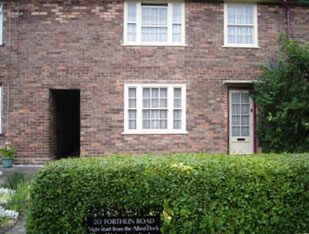 James Paul McCartney was born on 18 June 1942 in Walton Hospital, Liverpool, England, where his mother, Mary Patricia (née Mohin; 1909–1956), had qualified to practice as a nurse. His father, James (“Jim”) McCartney (1902–1976), was absent from his son’s birth due to his work as a volunteer firefighter during World War II. Paul has one younger brother, Michael (born 7 January 1944). Though the children were baptized in their mother’s Catholic faith, their father was a former Protestant turned agnostic, and religion was not emphasised in the household.
James Paul McCartney was born on 18 June 1942 in Walton Hospital, Liverpool, England, where his mother, Mary Patricia (née Mohin; 1909–1956), had qualified to practice as a nurse. His father, James (“Jim”) McCartney (1902–1976), was absent from his son’s birth due to his work as a volunteer firefighter during World War II. Paul has one younger brother, Michael (born 7 January 1944). Though the children were baptized in their mother’s Catholic faith, their father was a former Protestant turned agnostic, and religion was not emphasised in the household.
McCartney attended Stockton Wood Road Primary School in Speke from 1947 until 1949, when he transferred to Joseph Williams Junior School in Belle Vale because of overcrowding at Stockton. In 1953, with only three others out of ninety examinees, he passed the 11-Plus exam, meaning he could attend the Liverpool Institute, a grammar school rather than a secondary modern school. In 1954, he met schoolmate George Harrison on the bus from his suburban home in Speke. The two quickly became friends; McCartney later admitted: “I tended to talk down to him because he was a year younger.”
McCartney’s mother Mary was a midwife and the family’s primary wage earner; her earnings enabled them to move into 20 Forthlin Road in Allerton, where they lived until 1964. She rode a bicycle to her patients; McCartney described an early memory of her leaving at “about three in the morning [the] streets … thick with snow”. On 31 October 1956, when McCartney was fourteen, his mother died of an embolism.
McCartney’s loss later became a point of connection with John Lennon, whose mother, Julia, had died when he was seventeen.
McCartney’s father was a trumpet player and pianist, who had led Jim Mac’s Jazz Band in the 1920s. He kept an upright piano in the front room, encouraged his sons to be musical and advised Paul to take piano lessons, but Paul preferred to learn by ear. He gave Paul a nickel-plated trumpet for his fourteenth birthday, but when rock and roll became popular on Radio Luxembourg, McCartney traded it for a £15 Framus Zenith (model 17) acoustic guitar, since he wanted to be able to sing while playing.
He found it difficult to play guitar right-handed, but after noticing a poster advertising a Slim Whitman concert and realizing that Whitman played left-handed, he reversed the order of the strings. McCartney wrote his first song, “I Lost My Little Girl”, on the Zenith, and composed another early tune that would become “When I’m Sixty-Four” on the piano. American rhythm and blues influenced him, and Little Richard was his schoolboy idol; “Long Tall Sally” was the first song McCartney performed in public, at a Butlins holiday camp talent competition.
Career
1957–1960: The Quarrymen
At the age of fifteen, McCartney met Lennon and his band, the Quarrymen, at the St Peter’s Church Hall fête in Woolton on 6 July 1957. The Quarrymen played a mix of rock and roll and skiffle, a type of popular music with jazz, blues and folk influences. The band invited McCartney to join soon afterwards as a rhythm guitarist, and he formed a close working relationship with Lennon. Harrison joined in 1958 as lead guitarist, followed by Lennon’s art school friend Stuart Sutcliffe on bass, in 1960. By May 1960 the band had tried several names, including Beatals, Johnny and the Moondogs and the Silver Beetles. They adopted the name the Beatles in August 1960 and recruited drummer Pete Best shortly before a five-engagement residency in Hamburg.
1960–1970: The Beatles
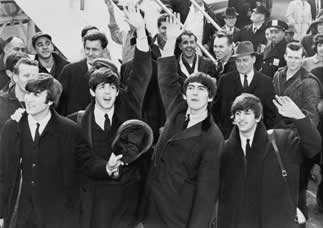
Informally represented by Allan Williams, the Beatles’ first booking was for a residency in Hamburg, starting in 1960. In 1961, Sutcliffe left the band and McCartney reluctantly became their bass player. They recorded professionally for the first time while in Hamburg, credited as the Beat Brothers, as the backing band for English singer Tony Sheridan on the single “My Bonnie”.
This brought them to the attention of Brian Epstein, a key figure in their subsequent development and success. He became their manager in January 1962. Ringo Starr replaced Best in August, and the band had their first hit, “Love Me Do”, in October, becoming popular in the UK in 1963, and in the US a year later. Their fans’ hysteria became known as “Beatlemania”, and the press sometimes referred to McCartney as the “cute Beatle”.
In August 1965, the Beatles released the McCartney composition “Yesterday”, featuring a string quartet. Included on the Help! LP, the song was the group’s first recorded use of classical music elements and their first recording that involved only a single band member. “Yesterday” became one of the most covered songs in popular music history. Later that year, during recording sessions for the album Rubber Soul, McCartney began to supplant Lennon as the dominant musical force in the band. Musicologist Ian MacDonald wrote, “from [1965] … [McCartney] would be in the ascendant not only as a songwriter, but also as instrumentalist, arranger, producer, and de facto musical director of the Beatles.”
Critics described Rubber Soul as a significant advance in the refinement and profundity of the band’s music and lyrics. Considered a high point in the Beatles catalogue, both Lennon and McCartney said they had written the music for the song “In My Life”.McCartney said of the album, “we’d had our cute period, and now it was time to expand.” In 1966, the Beatles released the album Revolver. Featuring sophisticated lyrics, studio experimentation, and an expanded repertoire of musical genres ranging from innovative string arrangements to psychedelic rock, the album marked an artistic leap for the Beatles.
The first of three consecutive McCartney A-sides, the single “Paperback Writer” preceded the LP’s release. The Beatles produced a short promotional film for the song, and another for its B-side, “Rain”. The films, described by Harrison as “the forerunner of videos”, aired on The Ed Sullivan Show and Top of the Pops in June 1966. Revolver also included McCartney’s “Eleanor Rigby”, which featured a string octet. According to Gould, the song is “a neoclassical tour de force … a true hybrid, conforming to no recognizable style or genre of song”. Except for some backing vocals, the song included only McCartney’s lead vocal and the strings arranged by producer George Martin.
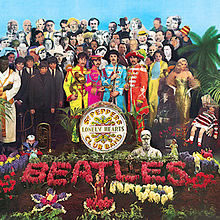 The band gave their final commercial concert at the end of their 1966 US tour. Later that year, McCartney completed his first musical project apart from the group—a film score for the UK production The Family Way. The score was collaboration with Martin, who used two McCartney themes to write thirteen variations. The soundtrack failed to chart, but it won McCartney an Ivor Novello Award for Best Instrumental Theme.
The band gave their final commercial concert at the end of their 1966 US tour. Later that year, McCartney completed his first musical project apart from the group—a film score for the UK production The Family Way. The score was collaboration with Martin, who used two McCartney themes to write thirteen variations. The soundtrack failed to chart, but it won McCartney an Ivor Novello Award for Best Instrumental Theme.
Upon the end of the Beatles’ performing career, McCartney sensed unease in the band and wanted them to maintain creative productivity. He pressed them to start a new project, which became Sgt. Pepper’s Lonely Hearts Club Band, widely regarded as rock’s first concept album. Inspired to create a new persona for the group, to serve as a vehicle for experimentation and to demonstrate to their fans that they had musically matured, McCartney invented the fictional band of the album’s title track.
Starting in November 1966, the band adopted an experimental attitude during recording sessions for the album. According to engineer Geoff Emerick, “the Beatles were looking to go out on a limb, both musically and sonically … we were utilising a lot of tape varispeeding and other manipulation techniques … limiters and … effects like flanging and ADT.” Their recording of “A Day in the Life” required a forty-piece orchestra, which Martin and McCartney took turns conducting. The sessions produced the double A-side single “Strawberry Fields Forever”/”Penny Lane” in February 1967, and the LP followed in June. McCartney’s “She’s Leaving Home” was an orchestral pop song. MacDonald described the track as “[among] the finest work on Sgt. Pepper—imperishable popular art of its time”.
Based on an ink drawing by McCartney, the LP’s cover included a collage designed by pop artists Peter Blake and Jann Haworth, featuring the Beatles in costume as the Sgt. Pepper’s Lonely Hearts Club Band, standing with a host of celebrities. The heavy moustaches worn by the Beatles reflected the growing influence of hippie style trends on the band, while their clothing “spoofed the vogue in Britain for military fashions”, wrote Gould. Scholar David Scott Kastan described Sgt. Pepper as “the most important and influential rock-and-roll album ever recorded”.
Epstein’s death in August 1967 created a void, which left the Beatles perplexed and concerned about their future. McCartney, stepping in to fill that void, gradually became the de facto leader and business manager of the group Lennon had once led. His first creative suggestion after this change of leadership was to propose that the band move forward on their plans to produce a film for television, which was to become Magical Mystery Tour. The project was “an administrative nightmare throughout”, according to Beatles’ historian Mark Lewisohn.
McCartney largely directed the film, which brought the group their first unfavourable critical response. However, the film’s soundtrack was more successful. It was released in the UK as a six-track double extended play disc (EP), and as an identically titled LP in the US, filled out with five songs from the band’s recent singles. The only Capitol compilation later included in the group’s official canon of studio albums, the Magical Mystery Tour LP achieved $8 million in sales within three weeks of its release, higher initial sales than any other Capitol LP up to that point.
In January 1968, EMI filmed the Beatles for a promotional trailer intended to advertise the animated film Yellow Submarine, loosely based on the imaginary world evoked by McCartney’s 1966 composition. Though critics admired the film for its visual style, humour and music, the soundtrack album issued seven months later received a less enthusiastic response. By late 1968, relations within the band were deteriorating. The tension grew during the recording of their self-titled double album, also known as the “White Album”. Matters worsened the following year during the Let It Be sessions, when a camera crew filmed McCartney lecturing the group: “We’ve been very negative since Mr. Epstein passed away … we were always fighting [his] discipline a bit, but it’s silly to fight that discipline if it’s our own”.
In March 1969, McCartney married Linda Eastman, and in August, the couple had their first child, Mary, named after his late mother. For Abbey Road, the band’s last recorded album, Martin suggested “a continuously moving piece of music”, urging the group to think symphonically. McCartney agreed, but Lennon did not. They eventually compromised, agreeing to McCartney’s suggestion: an LP featuring individual songs on side one, and a long medley on side two. In October 1969, a rumour surfaced that McCartney had died in a car crash in 1966 and been replaced by a lookalike, but this was quickly refuted when a November Life magazine cover featured him and his family, accompanied by the caption “Paul is still with us”.
On 10 April 1970, in the midst of business disagreements with his bandmates, McCartney announced his departure from the group. He filed suit for the band’s formal dissolution on 31 December 1970. More legal disputes followed as McCartney’s attorneys, his in-laws John and Lee Eastman, fought Lennon’s, Harrison’s, and Starr’s business manager, Allen Klein, over royalties and creative control. An English court legally dissolved the Beatles on 9 January 1975, though sporadic lawsuits against their record company EMI, Klein, and each other persisted until 1989 They are widely regarded as one of the most popular and influential acts in the history of rock music.
Prior to, and for a while after leaving the group, McCartney suffered from a depression. His wife helped him pull out of that emotional crisis by praising his work as a songwriter and convincing him to continue writing and recording. In her honor, he later wrote “Maybe I’m Amazed”, explaining that with the Beatles breaking up, “that was my feeling: Maybe I’m amazed at what’s going on… Maybe I’m a man and maybe you’re the only woman who could ever help me; Baby won’t you help me understand… Maybe I’m amazed at the way you pulled me out of time, hung me on the line, Maybe I’m amazed at the way I really need you.” He added that “every love song I write is for Linda.”
1970–1981: Wings
After the Beatles’ break-up in 1970, McCartney continued his musical career with his first solo release, McCartney, a US number-one album. Apart from some vocal contributions from Linda, McCartney is a one-man album, with Paul providing compositions, instrumentation and vocals. In 1971, he collaborated with Linda and drummer Denny Seiwell on a second album, Ram. A UK number one and a US top five; Ram included the co-written US number-one hit single “Uncle Albert/Admiral Halsey”. Later that year, ex-Moody Blues guitarist Denny Laine joined the McCartney’s and Seiwell to form the band Wings. McCartney had this to say on the group’s formation: “Wings were always a difficult idea … any group having to follow [the Beatles’] success would have a hard job … I found myself in that very position. However, it was a choice between going on or finishing, and I loved music too much to think of stopping.” In September 1971, the McCartney’s’ daughter Stella was born, named in honour of Linda’s grandmothers, both of whom were named Stella.
Following the addition of guitarist Henry McCullough, Wings’ first concert tour began in 1972 with a debut performance in front of an audience of seven hundred at the University of Nottingham. Ten more gigs followed as they travelled across the UK in a van during an unannounced tour of universities, during which the band stayed in modest accommodation and received pay in coinage collected from students, while avoiding Beatles songs during their performances. McCartney later said, “The main thing I didn’t want was to come on stage, faced with the whole torment of five rows of press people with little pads, all looking at me and saying, ‘Oh well, he is not as good as he was.’ So we decided to go out on that university tour which made me less nervous … by the end of that tour I felt ready for something else, so we went into Europe.” During the seven-week, 25-show Wings Over Europe Tour, the band played almost solely Wings and McCartney solo material: the Little Richard cover “Long Tall Sally” was the only song that had previously been recorded by the Beatles. McCartney wanted the tour to avoid large venues; most of the small halls they played had capacities of fewer than 3,000 people.
In March 1973, Wings achieved their first US number-one single, “My Love”, included on their second LP, Red Rose Speedway, a US number one and UK top five. Paul’s collaboration with Linda and former Beatles producer Martin resulted in the song “Live and Let Die”, which was the theme song for the James Bond film of the same name. Nominated for an Academy Award, the song reached number two in the US and number nine in the UK. It also earned Martin a Grammy for his orchestral arrangement. Music professor and author Vincent Benitez described the track as “symphonic rock at its best”.
After the departure of McCullough and Seiwell in 1973, the McCartneys and Laine recorded Band on the Run. The album was the first of seven platinum Wings LPs. It was a US and UK number one, the band’s first to top the charts in both countries and the first ever to reach Billboard magazine’s charts on three separate occasions. One of the best-selling releases of the decade, it remained on the UK charts for 124 weeks. Rolling Stone named it one of the Best Albums of the Year for 1973, and in 1975 Paul McCartney and Wings won the Grammy Award for Best Pop Vocal Performance for the song “Band on the Run” and Geoff Emerick won the Grammy for Best Engineered Recording for the album. In 1974, Wings achieved a second US number-one single with the title track. The album also included the top-ten hits “Jet” and “Helen Wheels”, and earned the 413th spot on Rolling Stone’s list of the 500 Greatest Albums of All Time.
Wings followed Band on the Run with the chart-topping albums Venus and Mars (1975) and Wings at the Speed of Sound (1976). In 1975, they began the fourteen-month Wings Over the World Tour, which included stops in the UK, Australia, Europe and the US. The tour marked the first time McCartney performed Beatles songs live with Wings, with five in the two-hour set list: “I’ve Just Seen a Face”, “Yesterday”, “Blackbird”, “Lady Madonna” and “The Long and Winding Road”. Following the second European leg of the tour and extensive rehearsals in London, the group undertook an ambitious US arena tour that yielded the US number-one live triple LP Wings over America.
In September 1977, the McCartneys had a third child, a son they named James. In November, the Wings song “Mull of Kintyre”, co-written with Laine, was quickly becoming one of the best-selling singles in UK chart history. The most successful single of McCartney’s solo career, it achieved double the sales of the previous record holder, “She Loves You”, and went on to sell 2.5 million copies and hold the UK sales record until the 1984 charity single, “Do They Know It’s Christmas?”
London Town (1978) spawned a US number-one single (“With a Little Luck”), and was Wings’ best-selling LP since Band on the Run, making the top five in both the US and the UK. Critical reception was unfavorable, and McCartney expressed disappointment with the album. Back to the Egg (1979) featured McCartney’s collaboration with a rock supergroup dubbed “the Rockestra”. Credited to Wings, the band included Pete Townshend, David Gilmour, Gary Brooker, John Paul Jones and John Bonham. Though certified platinum, critics panned the album. Wings completed their final concert tour in 1979, with twenty shows in the UK that included the live debut of the Beatles songs “Got to Get You into My Life”, “The Fool on the Hill” and “Let it Be”.
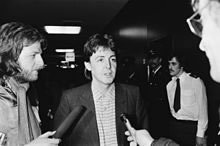 In 1980, McCartney released his second solo LP, the self-produced McCartney II, which peaked at number one in the UK and number three in the US.
In 1980, McCartney released his second solo LP, the self-produced McCartney II, which peaked at number one in the UK and number three in the US.
As with his first album, he composed and performed it alone. The album contained the song “Coming Up”, the live version of which, recorded in Glasgow, Scotland, in 1979 by Wings, became the group’s last number-one hit. By 1981, McCartney felt he had accomplished all he could creatively with Wings and decided he needed a change. The group disbanded in April 1981 following disagreements over royalties and salaries.
1982–1989
In 1982 McCartney collaborated with Stevie Wonder on the Martin-produced number-one hit “Ebony and Ivory”, included on McCartney’s Tug of War LP, and with Michael Jackson on “The Girl Is Mine” from Thriller. “Ebony and Ivory” was McCartney’s record 28th single to hit number one on the Billboard 100. The following year, he and Jackson worked on “Say Say Say”, McCartney’s most recent US number one as of 2014. McCartney earned his latest UK number one as of 2014 with the title track of his LP release that year, “Pipes of Peace”.
In 1984, McCartney starred in the musical Give My Regards to Broad Street, a feature film he also wrote and produced which included Starr in an acting role. Disparaged by critics, Variety described the film as “characterless, bloodless, and pointless”. Roger Ebert awarded it a single star and wrote, “you can safely skip the movie and proceed directly to the soundtrack”. The album fared much better, reaching number one in the UK and producing the US top-ten hit single “No More Lonely Nights”, featuring David Gilmour on lead guitar. In 1985, Warner Brothers commissioned McCartney to write a song for the comedic feature film Spies Like Us. He composed and recorded the track in four days, with Phil Ramone co-producing. McCartney participated in Live Aid, performing “Let it Be”, but technical difficulties rendered his vocals and piano barely audible for the first two verses, punctuated by squeals of feedback. Equipment technicians resolved the problems and David Bowie, Alison Moyet, Pete Townshend and Bob Geldof joined McCartney on stage, receiving an enthusiastic crowd reaction.
McCartney collaborated with Eric Stewart on Press to Play (1986), with Stewart co-writing more than half the songs on the LP. In 1988, McCartney released Choba B CCCP, released only in the Soviet Union, which contained eighteen covers; recorded over the course of two days. In 1989, he joined forces with fellow Merseysiders Gerry Marsden and Holly Johnson to record an updated version of “Ferry Cross the Mersey”, for the Hillsborough disaster appeal fund.
That same year, he released Flowers in the Dirt; a collaborative effort with Elvis Costello that included musical contributions from Gilmour and Nicky Hopkins. McCartney then formed a band consisting of himself and Linda, with Hamish Stuart and Robbie McIntosh on guitars, Paul “Wix” Wickens on keyboards and Chris Whitten on drums. In September 1989, they launched the Paul McCartney World Tour, his first in over a decade. The following year, he released the triple album, Tripping the Live Fantastic, which contained select performances from the tour.
1991–2000
In 1990, the US publication Amusement Business presented McCartney with an award for the highest grossing show of the year; his two performances at Berkeley earned over $3.5 million. He performed for the largest paying stadium audience in history on 21 April 1990, when 184,000 people attended his concert at Maracanã Stadium in Rio de Janeiro, Brazil.
McCartney ventured into orchestral music in 1991, when the Royal Liverpool Philharmonic Society commissioned a musical piece by him to celebrate its sesquicentennial. He collaborated with composer Carl Davis, producing Liverpool Oratorio. The performance featured opera singers Kiri Te Kanawa, Sally Burgess, Jerry Hadley and Willard White, with the Royal Liverpool Philharmonic Orchestra and the choir of Liverpool Cathedral. Reviews were negative. The Guardian was especially critical, describing the music as “afraid of anything approaching a fast tempo”, and adding that the piece has “little awareness of the need for recurrent ideas that will bind the work into a whole”. The paper published a letter McCartney submitted in response in which he noted several of the work’s faster tempos and added, “happily, history shows that many good pieces of music were not liked by the critics of the time so I am content to … let people judge for themselves the merits of the work.” The New York Times was slightly more generous, stating, “There are moments of beauty and pleasure in this dramatic miscellany … the music’s innocent sincerity makes it difficult to be put off by its ambitions”. Performed around the world after its London premiere, the Liverpool Oratorio reached number one on the UK classical chart, Music Week.
In 1991, McCartney performed a selection of acoustic-only songs on MTV Unplugged and released a live album of the performance titled Unplugged (The Official Bootleg). During the 1990s, McCartney collaborated twice with Youth of Killing Joke as the musical duo “the Fireman”. The two released their first electronica album together, Strawberries Oceans Ships Forest, in 1993. McCartney released the rock album Off the Ground in 1993. The subsequent New World Tour followed, which led to the release of the Paul Is Live album later that year.
Starting in 1994, McCartney took a four-year break from his solo career to work on Apple’s Beatles Anthology project with Harrison, Starr and Martin. He recorded a radio series called Oobu Joobu in 1995 for the American network Westwood One, which he described as “widescreen radio”. Also in 1995, Prince Charles presented him with an Honorary Fellowship of the Royal College of Music—”kind of amazing for somebody who doesn’t read a note of music”, commented McCartney.
In 1997, McCartney released the rock album Flaming Pie. Starr appeared on drums and backing vocals in “Beautiful Night”.Later that year, he released the classical work Standing Stone, which topped the UK and US classical charts. In 1998, he released Rushes, the second electronica album by the Fireman. In 1999, McCartney released Run Devil Run. Recorded in one week, and featuring Ian Paice and David Gilmour, it was primarily an album of covers with three McCartney originals. He had been planning such an album for years, having been previously encouraged to do so by Linda, who had died of cancer in April 1998.
McCartney did an unannounced performance at the benefit tribute, “Concert for Linda,” his wife of 29 years who died a year earlier. It was held at the Royal Albert Hall in London on 10 April 1999, and was organized by two of her close friends, Chrissie Hynde and Carla Lane. Also during 1999, he continued his experimentation with orchestral music on Working Classical.
2000–2010
In 2000, he released the electronica album Liverpool Sound Collage with Super Furry Animals and Youth, using the sound collage and musique concrète techniques that had fascinated him in the mid-1960s. He contributed the song “Nova” to a tribute album of classical, choral music called A Garland for Linda (2000), dedicated to his late wife.
Having witnessed the 11 September 2001 attacks from the JFK airport tarmac, McCartney was inspired to take a leading role in organizing the Concert for New York City. His studio album release in November that year, Driving Rain, included the song “Freedom”, written in response to the attacks. The following year, McCartney went out on tour with a band that included guitarists Rusty Anderson and Brian Ray, accompanied by Paul “Wix” Wickens on keyboards and Abe Laboriel, Jr. on drums. They began the Driving World Tour in April 2002, which included stops in the US, Mexico and Japan. The tour resulted in the double live album Back in the US, released internationally in 2003 as Back in the World. The tour earned a reported $126.2 million, an average of over $2 million per night, and Billboard named it the top tour of the year. The team continued to play together and McCartney played live with Brian Ray, Rusty Anderson, Abe Laboriel Jr. and Wix Wickens longer than he played live with the Beatles.
In July 2002, McCartney married Heather Mills. In November, on the first anniversary of George Harrison’s death, McCartney performed at the Concert for George. He participated in the National Football League’s Super Bowl, performing “Freedom” during the pre-game show for Super Bowl XXXVI in 2002 and headlining the halftime show at Super Bowl XXXIX in 2005. The English College of Arms honoured McCartney in 2002 by granting him a coat of arms. His crest, featuring a Liver bird holding an acoustic guitar in its claw, reflects his background in Liverpool and his musical career. The shield includes four curved emblems which resemble beetles’ backs. The arms’ motto is Ecce Cor Meum, Latin for “Behold My Heart”. In 2003, the McCartney’s had a child, Beatrice Milly.
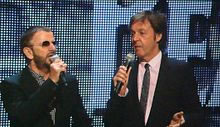 In July 2005, he performed at the Live 8 event in Hyde Park, London, opening the show with “Sgt. Pepper’s Lonely Hearts Club Band” (with U2) and closing it with “Drive My Car” (with George Michael), “Helter Skelter”, and “The Long and Winding Road”. In September, he released the rock album Chaos and Creation in the Backyard, for which he provided most of the instrumentation.
In July 2005, he performed at the Live 8 event in Hyde Park, London, opening the show with “Sgt. Pepper’s Lonely Hearts Club Band” (with U2) and closing it with “Drive My Car” (with George Michael), “Helter Skelter”, and “The Long and Winding Road”. In September, he released the rock album Chaos and Creation in the Backyard, for which he provided most of the instrumentation.
In 2006, McCartney released the classical work Ecce Cor Meum. The rock album Memory Almost Full followed in 2007. In 2008, he released his third Fireman album, Electric Arguments. Also in 2008, he performed at a concert in Liverpool to celebrate the city’s year as European Capital of Culture. In 2009, after a four-year break, he returned to touring and has since performed over 80 shows. More than forty-five years after the Beatles first appeared on American television during The Ed Sullivan Show, he returned to the same New York theater to perform on Late Show with David Letterman. On 9 September 2009, EMI reissued the Beatles catalogue following a four-year digital remastering effort, releasing a music video game called The Beatles: Rock Band the same day.
McCartney’s enduring fame has made him a popular choice to open new venues. In 2009, he played three sold-out concerts at the newly built Citi Field—a venue constructed to replace Shea Stadium in Queens, New York. These performances yielded the double live album Good Evening New York City later that year.
Musicianship
Largely a self-taught musician, McCartney’s approach was described by musicologist Ian MacDonald as “by nature drawn to music’s formal aspects yet wholly untutored … [he] produced technically ‘finished’ work almost entirely by instinct, his harmonic judgement based mainly on perfect pitch and an acute pair of ears … [A] natural melodist—a creator of tunes capable of existing apart from their harmony”. McCartney commented, “I prefer to think of my approach to music as … rather like the primitive cave artists, who drew without training.”
Bass guitar
McCartney’s skill as a bass player has been acknowledged by other bassists, including Sting, Dr. Dre bassist Mike Elizondo, and Colin Moulding of XTC. Best known for primarily using a plectrum or pick, McCartney occasionally plays fingerstyle. He does not use slapping or muting techniques. He was strongly influenced by Motown artists, in particular James Jamerson, who McCartney called a hero for his melodic style. He was also influenced by Brian Wilson, as he commented: “because he went to very unusual places”. Another favourite bassist of his is Stanley Clarke.
During McCartney’s early years with the Beatles, he primarily used a Höfner 500/1 bass, though in 1965, he began sporadically using a Rickenbacker 4001S for recording. While typically using Vox amplifiers, by 1967 he had also begun using a Fender Bassman for amplification. During the late 1980s and early 1990s, he used a Wal 5-String, which he said made him play more thick-sounding basslines, in contrast to the much lighter Höfner, which inspired him to play more sensitively, something he considers fundamental to his playing style. He changed back to the Höfner around 1990 for that reason. He uses Mesa Boogie bass amplifiers while performing live.
MacDonald identified “She’s a Woman” as the turning point when McCartney’s bass playing began to evolve dramatically, and Beatles biographer Chris Ingham singled out Rubber Soul as the moment when McCartney’s playing exhibited significant progress, particularly on “The Word”. Bacon and Morgan agreed, calling McCartney’s groove on the track “a high point in pop bass playing and … the first proof on a recording of his serious technical ability on the instrument.” MacDonald inferred the influence of James Brown’s “Papa’s Got a Brand New Bag” and Wilson Pickett’s “In the Midnight Hour”, American soul tracks from which McCartney absorbed elements and drew inspiration as he “delivered his most spontaneous bass-part to date”.
Bacon and Morgan described his bassline for the Beatles song “Rain” as “an astonishing piece of playing … [McCartney] thinking in terms of both rhythm and ‘lead bass’ … [choosing] the area of the neck … he correctly perceives will give him clarity for melody without rendering his sound too thin for groove. MacDonald considered the track the Beatles’ best B-side, stating that its “clangorously saturated texture resonates around McCartney’s [bassline]”, which MacDonald described as “so inventive that it threatens to overwhelm the track”. MacDonald also indicated the influence of Indian classical music in “exotic melismas in the bass part”. McCartney identified Sgt. Pepper’s Lonely Hearts Club Band as containing his strongest and most inventive bass playing, particularly on “Lucy in the Sky with Diamonds”.
Acoustic guitar
McCartney primarily flatpicks while playing acoustic guitar, though he also uses elements of fingerpicking. Examples of his acoustic guitar playing on Beatles tracks include “Yesterday”, “I’m Looking Through You”, “Michelle”, “Blackbird”, “I Will”, “Mother Nature’s Son” and “Rocky Raccoon”. McCartney singled out “Blackbird” as a personal favourite and described his technique for the guitar part in the following way: “I got my own little sort of cheating way of [fingerpicking] … I’m actually sort of pulling two strings at a time … I was trying to emulate those folk players.” He employed a similar technique for “Jenny Wren”. He played an Epiphone Texan on many of his acoustic recordings, but also used a Martin D-28.
Electric guitar
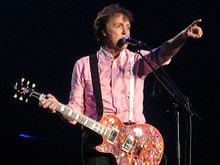 McCartney played lead guitar on several Beatles recordings, including what MacDonald described as a “fiercely angular slide guitar solo” on “Drive My Car”, which McCartney played on an Epiphone Casino. McCartney said of the instrument, “if I had to pick one electric guitar it would be this.”
McCartney played lead guitar on several Beatles recordings, including what MacDonald described as a “fiercely angular slide guitar solo” on “Drive My Car”, which McCartney played on an Epiphone Casino. McCartney said of the instrument, “if I had to pick one electric guitar it would be this.”
He contributed what MacDonald described as “a startling guitar solo” on the Harrison composition “Taxman” and the “shrieking” guitar on “Sgt. Pepper’s Lonely Hearts Club Band” and “Helter Skelter”. MacDonald also praised McCartney’s “coruscating pseudo-Indian” guitar solo on “Good Morning Good Morning”.
McCartney also played lead guitar on “Another Girl”. While in Wings, McCartney tended to leave electric guitar work to other group members, though he played most of the lead guitar on Band on the Run.
In 1990, when asked who his favorites guitar players were he included Eddie Van Halen, Eric Clapton and David Gilmour, stating, “but I still like Hendrix the best”. He has primarily used a Gibson Les Paul for electric work, particularly during live performances.
Vocals
Often renowned as one of the greatest singers in pop music, McCartney was ranked the 11th greatest singer of all time by Rolling Stone, voted the 8th greatest singer ever by NME readers and number 10 by Music Radar readers in the list of “the 30 greatest lead singers of all time”.
He is known for his belting power, versatility and wide tenor vocal range, spanning over four octaves. Heavily influenced by Little Richard, McCartney’s vocals would cross several musical genres throughout his career. On “Call Me Back Again”, according to Benitez, “McCartney shines as a bluesy solo vocalist” while MacDonald called “I’m Down” “a rock-and-roll classic” that “illustrates McCartney’s vocal and stylistic versatility”. MacDonald described “Helter Skelter” as an early attempt at heavy metal, and “Hey Jude” as a “pop/rock hybrid”, pointing out McCartney’s “use of gospel-style melismas” in the song and his “pseudo-soul shrieking in the fade-out”. Benitez identified “Hope of Deliverance” and “Put It There” as examples of McCartney’s folk music efforts while musicologist Walter Everett considered “When I’m Sixty-Four” and “Honey Pie” attempts at vaudeville.
MacDonald praised the “swinging beat” of the Beatles’ twenty-four bar blues song, “She’s a Woman” as “the most extreme sound they had manufactured to date”, with McCartney’s voice “at the edge, squeezed to the upper limit of his chest register and threatening to crack at any moment.” MacDonald described “I’ve Got a Feeling” as a “raunchy, mid-tempo rocker” with a “robust and soulful” vocal performance and “Back in the U.S.S.R.” as “the last of [the Beatles’] up-tempo rockers”, McCartney’s “belting” vocals among his best since “Drive My Car”, recorded three years earlier.
McCartney also teasingly tried out classical singing, namely singing various renditions of “Besame Mucho” with the rest of The Beatles. He would continue wildly experimenting with various musical and vocal styles throughout his post-Beatles career as a solo artist, “Monkberry Moon Delight” being named by Pitchfork’s Jayson Greene as “an absolutely unhinged vocal take, Paul gulping and sobbing right next to your inner ear”, adding that “it could be a latter-day Tom Waits performance”.
Over the years, McCartney has been named a significant vocal influence by a number of renowned artists, including Chris Cornell, Billy Joel, Steven Tyler, Brad Delp and Axl Rose.
Keyboards
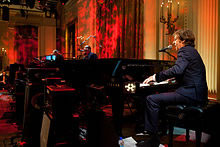 McCartney played piano on several Beatles songs, including “Every Little Thing”, “She’s a Woman”, “For No One”, “A Day in the Life”, “Hello, Goodbye”, “Hey Jude”, “Lady Madonna”, “Let It Be” and “The Long and Winding Road”.
McCartney played piano on several Beatles songs, including “Every Little Thing”, “She’s a Woman”, “For No One”, “A Day in the Life”, “Hello, Goodbye”, “Hey Jude”, “Lady Madonna”, “Let It Be” and “The Long and Winding Road”.
MacDonald considered the piano part in “Lady Madonna” as reminiscent of Fats Domino, and “Let It Be” as having a gospel rhythm. MacDonald called McCartney’s Mellotron intro on “Strawberry Fields Forever” an integral feature of the song’s character. McCartney played a Moog synthesizer on the Beatles song “Maxwell’s Silver Hammer” and the Wings track “Loup (1st Indian on the Moon)”. Ingham described the Wings songs “With a Little Luck” and “London Town” as “full of the most sensitive pop synthesizer touches”.
Drums
McCartney played drums on the Beatles’ songs “Back in the U.S.S.R.”, “Dear Prudence”, “Martha My Dear”, “Wild Honey Pie” and “The Ballad of John and Yoko”. He also played all the drum parts on his first and second solo albums McCartney and McCartney II, as well as on the Wings album Band on the Run and most of the drums on his solo LP Chaos and Creation in the Backyard. McCartney also played drums on Paul Jones’ rendition of “And the Sun Will Shine” in 1968. Using the pseudonym Paul Ramon, which he had first used during the Beatles first tour in Scotland in 1960, McCartney played drums on Steve Miller Band’s 1969 tracks “Celebration Song” and “My Dark Hour”.
Tape loops
In the mid-1960s, when visiting artist friend John Dunbar’s flat in London, McCartney brought tapes he had compiled at then-girlfriend Jane Asher’s home. They included mixes of various songs, musical pieces and comments made by McCartney that Dick James made into a demo for him. Heavily influenced by American avant-garde musician John Cage, McCartney made tape loops by recording voices, guitars and bongos on a Brenell tape recorder and splicing the various loops. He referred to the finished product as “electronic symphonies”. He reversed the tapes, speeded them up, and slowed them down to create the desired effects, some of which the Beatles later used on the songs “Tomorrow Never Knows” and “The Fool on the Hill”.
Early influences
McCartney’s earliest musical influences include Little Richard, Elvis Presley, Buddy Holly, Carl Perkins, and Chuck Berry. When asked why the Beatles did not include Presley on the Sgt. Pepper cover, McCartney replied, “Elvis was too important and too far above the rest even to mention … so we didn’t put him on the list because he was more than merely a … pop singer, he was Elvis the King.” McCartney stated that for his bassline for “I Saw Her Standing There”, he directly quoted Berry’s “I’m Talking About You”.
McCartney called Little Richard an idol, whose falsetto vocalizations inspired McCartney’s own vocal technique. McCartney said he wrote “I’m Down” as a vehicle for his Little Richard impersonation. In 1971, McCartney bought the publishing rights to Holly’s catalogue, and in 1976, on the fortieth anniversary of Holly’s birth, McCartney inaugurated the annual “Buddy Holly Week” in England. The festival has included guest performances by famous musicians, songwriting competitions, drawing contests and special events featuring performances by the Crickets.
Linda McCartney (1941-1998)
Linda McCartney was an American musician, photographer, animal rights activist, entrepreneur and publisher who was married to Paul McCartney of the Beatles. Prior to marrying Paul, she was a professional photographer of celebrities and contemporary musicians, with her work published in music industry magazines. Her photos were also published in the book Linda McCartney’s Sixties: Portrait of an Era, in 1992.
Linda married McCartney in 1969 at St John’s Wood Church in London. Her daughter, Heather Louise, from her first marriage to Melville See, was adopted by her new husband. Together, the McCartney’s had three other children.
In 1971, after they married and following the break-up of the Beatles the previous year, Paul and Linda McCartney recorded the album Ram. Shortly afterwards, they formed the band Wings. She continued to be part of her husband’s touring band following Wings’ break-up in 1981 up until The New World Tour in 1993.
She was an animal rights activist and wrote and published several vegetarian cookbooks, and founded the Linda McCartney Foods company with her husband.
In 1995 she was diagnosed with breast cancer and died from the disease in 1998 at the age of 56.
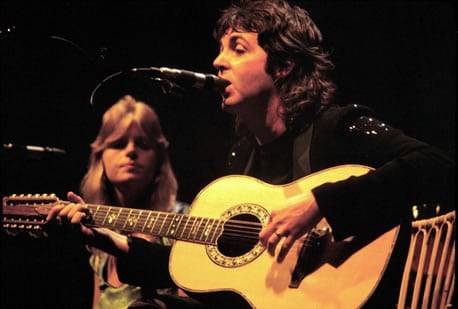
Wings
Wings were an Anglo-American rock band formed in 1971 by former Beatle Paul McCartney with his wife Linda on keyboards, session drummer Denny Seiwell, and former Moody Blues guitarist Denny Laine. Wings were noted for frequent personnel changes as well as commercial success, going through three lead guitarists and four drummers. However, the core trio of the McCartneys and Laine remained intact throughout the group’s existence.
Created following the McCartneys’ 1971 album Ram, the band’s first two albums, Wild Life and Red Rose Speedway (the latter featuring guitarist Henry McCullough), were viewed as artistic disappointments beside Paul McCartney’s work with the Beatles. After the release of the title track of the James Bond movie Live and Let Die, McCullough and Seiwell resigned from the band. The McCartneys and Laine then released 1973’s Band on the Run, a commercial and critical success that spawned two top ten singles in “Jet” and the title track. Following that album, the band recruited guitarist Jimmy McCulloch and drummer Geoff Britton, only for Britton to quit shortly afterwards and be replaced by Joe English. With the new line-up, Wings released Venus and Mars, which included the US number one single “Listen to What the Man Said”, and undertook a highly successful world tour over 1975–76. Intended as more of a group effort, Wings at the Speed of Sound was issued midway through the tour and featured the hit singles “Silly Love Songs” and “Let ‘Em In”.
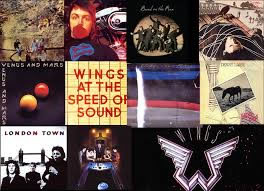 In 1977, the band earned their only UK number one single, with “Mull of Kintyre”, which became the then-best selling UK single in history. Wings experienced another line-up shuffle, however, with both McCulloch and English departing before the release of the group’s 1978 album London Town. The McCartneys and Laine again added new members, recruiting guitarist Laurence Juber and drummer Steve Holley. The resulting album, Back to the Egg, was a relative flop, with its singles under-performing and the critical reception negative. During the supporting tour, Paul McCartney was arrested in Japan for cannabis possession, putting the band on hold. Despite a final US number one, the live version of McCartney’s solo single “Coming Up”, Wings broke up permanently in 1981.
In 1977, the band earned their only UK number one single, with “Mull of Kintyre”, which became the then-best selling UK single in history. Wings experienced another line-up shuffle, however, with both McCulloch and English departing before the release of the group’s 1978 album London Town. The McCartneys and Laine again added new members, recruiting guitarist Laurence Juber and drummer Steve Holley. The resulting album, Back to the Egg, was a relative flop, with its singles under-performing and the critical reception negative. During the supporting tour, Paul McCartney was arrested in Japan for cannabis possession, putting the band on hold. Despite a final US number one, the live version of McCartney’s solo single “Coming Up”, Wings broke up permanently in 1981.
